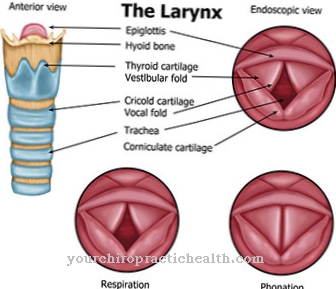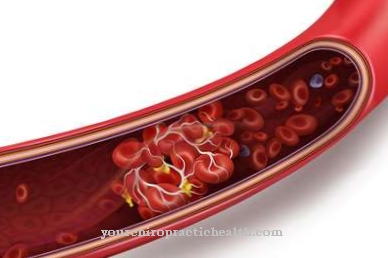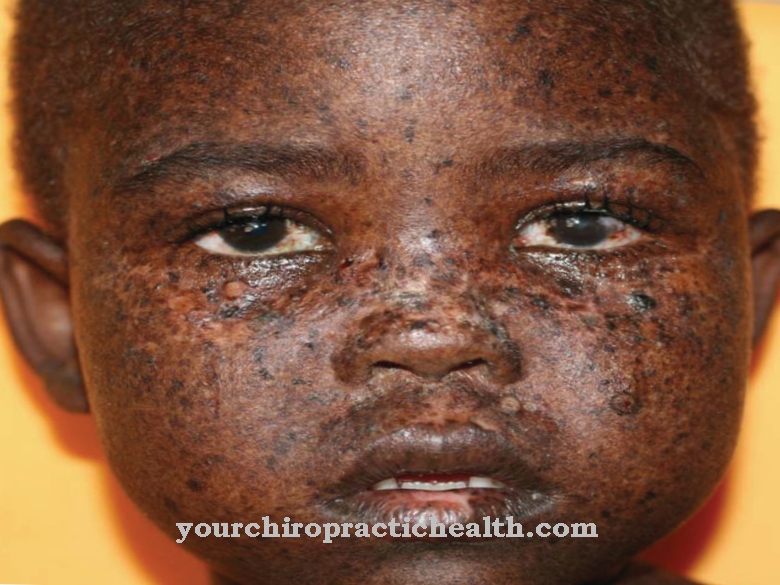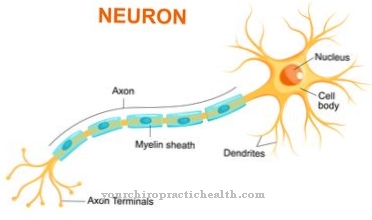The Diamond Blackfan Syndrome is an anemic disease, the origin of which is still unclear. Diamond Blackfan Syndrome can be treated relatively well and sometimes even cured. However, preventive measures are not possible.
What is Diamond Blackfan Syndrome?
The doctor referred to as Diamond Blackfan Syndrome - also as Erythrogenesis imperfecta or chronic congenital hypoplastic anemia and Diamond-Blackfan anemia (short: DBA) known - chronic anemia, which is characterized by the low number of red blood cells in the blood. Diamond-Blackfan syndrome mainly occurs at the beginning of the first year of life.
causes
Diamond-Blackfan syndrome is an anemic disease and a so-called special form of the well-known aplastic anemia, which subsequently has a selective disruption of the production of red blood cells.
Diamond-Blackfan syndrome is inherited as either an autosomal dominant or an autosomal recessive trait. The change or mutation is on chromosome 19 (position 13). In many cases, Diamond-Blackfan syndrome is not inherited, but occurs sporadically (spontaneous mutation). In only 15 percent of all cases there is inheritance from a parent.
So far, the real cause why Diamond Blackfan Syndrome occurs is not known. However, doctors suspect that it is a congenital anomaly of the so-called erythrocyte stem cells. Due to the anomaly, the erythrocyte stem cells that are in the bone marrow are undersupplied, so that there is also a low number of red blood cells.
Due to the fact that the cause is not known, doctors mainly act with symptomatic therapy or prevention of the syndrome is not possible. But even if the cause of Diamond Blackfan Syndrome is unknown, medical professionals can very well cure the disease.
Symptoms, ailments & signs

© Henrie - stock.adobe.com
Diamond-Blackfan syndrome occurs predominantly during the first six months; In 50 percent of all cases, the first symptoms appear after three months of life. About a fifth of the cases, the Diamond-Blackfan-Syndrome can already be determined after the birth, since the newborns are born with the "typical pallor".
In many cases, people with Diamond Blackfan Syndrome suffer from malformations. Doctors diagnose microcephaly (a very small skull), a cleft lip and palate or even very small eyeballs (microphthalmos). Sometimes hypertelorism (eyes set very far apart) or an unnaturally high palate can also be diagnosed; all of those points are classic for Diamond-Blackfan Syndrome.
Furthermore, 50 percent of all those affected are short; about a third of those affected suffer from a heart defect or have malformations of the fingers or thumbs and malformations of the kidneys. Sometimes mental development can also be delayed.
The course of the disease is positive. Of course there are also strong characteristics; As a rule, however, Diamond-Blackfan Syndrome can be treated well or sometimes even cured.
diagnosis
The so-called erythroblast deficiency is characteristic of the Diamond-Blackfan syndrome. Congenital erythroblastophthisis (the erythropoietic tissue in the bone marrow decreases) with reticulocytopenia, any malformations of the genital tract or the classic facial expression of the person affected (pseudomongoloid habit) are typical features of the Diamond-Blackfan syndrome.
Other signs that suggest that it is Diamond Blackfan Syndrome: microcephalus, Gothic palate, microphthalmos or hypertelorism. Even if these are classic features, the doctor must also have blood tests carried out.
Blood tests can determine whether or not you have Diamond Blackfan Syndrome. While those not affected have a hemoglobin value (Hb value) of over 11 g / dl, the value in Diamond-Blackfan syndrome is below 6 g / dl. The doctor can diagnose Diamond-Blackfan syndrome with a blood test and bone marrow puncture, through which the changes can be determined.
In around 20 to 25 percent of all cases, Diamond-Blackfan Syndrome can also be diagnosed using a genetic test. The doctor found a mutation in the so-called RPS19 gene, which subsequently triggers the Diamond-Blackfan syndrome.
Complications
The Diamond-Blackfan-Syndrome occurs in babies and children at a very young age and leads to an extremely pale face and also the whole body. In addition, many patients also suffer from small eyeballs or eyes that are relatively wide apart, so that the patient's self-esteem is also reduced by the syndrome. Often there is also a cleft lip and palate.
Those affected are also short stature and suffer from various heart defects. The heart defects can reduce life expectancy. In rare cases, Diamond-Blackfan Syndrome also restricts the child's psychological development, so that retardation can occur.
Diamond-Blackfan syndrome can be treated relatively well with cortisone; in most cases, treatment leads to a positive outcome. Serious cases can also be treated with bone marrow transplants. Under certain circumstances, the syndrome can also be completely cured, so that there are no further complications in the course of life. The heart defect should be examined regularly by a doctor and treated if necessary so that it does not lead to complications.
When should you go to the doctor?
Children born with malformations should always be examined and placed under medical observation. If, in addition to the typical signs - including very small eyeballs, widely spaced eyes or cleft lip and palate - there is a noticeable pale face, it is possible that you have Diamond-Blackfan Syndrome. In this case, parents should speak to the pediatrician immediately. Symptoms such as short stature, malformations of the fingers and signs of kidney or heart disease are best clarified immediately.
If the syndrome is recognized and treated early, the chances of recovery are generally relatively good. Therefore, go to the doctor if the symptoms mentioned are noticed. If there are recurrent symptoms and symptoms of the syndrome later in life, a medical clarification is always necessary. In addition, psychological support should also be consulted, as the Diamond-Black Syndrome often leads to emotional complaints such as depression or inferiority complexes. If cardiovascular problems or signs of kidney failure become noticeable, the emergency doctor must be alerted immediately.
Doctors & therapists in your area
Treatment & Therapy
The Diamond-Blackfan-Syndrome can be treated relatively well with corticosteroids. Studies have already shown that around 82 percent of all those affected respond very well to corticosteroid therapy; However, it is important that those affected only come into contact with the corresponding therapy after the first year of life.
People who are still in their first year of life or who actually do not respond to treatment with corticosteroids receive blood transfusions so that Diamond-Blackfan syndrome can be treated. It is important that the doctor prevents iron from building up in the body; The doctor speaks of hemosiderosis, which must be prevented in any case.
Another therapeutic option is stem cell transplantation or bone marrow transplantation - BMT. With this treatment it is possible that the Diamond-Blackfan-Syndrome can be cured. In particular, people who are dependent on transfusions because they cannot tolerate the corticosteroid therapy are repeatedly treated with transplants, as the frequent transfusions sometimes damage the organs.
Currently, bone marrow transplant is the only therapy that can actually cure Diamond Blackfan Syndrome. However, a donation from a non-family member is so risky that in individual cases it has to be weighed whether one should take the risk or not. The bone marrow transplant is the only form of treatment that can definitely cure the syndrome. Other treatment options that have a similar effect are currently unknown.
Outlook & forecast
Since the cause and development of the Diamond-Blackfan syndrome are still unclear, no causal therapy can be carried out for this disease. Those affected are therefore dependent on purely symptomatic treatment in order to alleviate the symptoms.
If there is no treatment for Diamond Blackfan Syndrome, the patient suffers from a heart defect and malformations of the kidneys. There can also be delays in intellectual development if the person concerned is not given appropriate support, causing retardation. Due to the cleft palate, many patients suffer from discomfort when ingesting food and liquids. The various malformations can in some cases also lead to teasing or bullying and therefore also cause psychological complaints.
The syndrome is usually treated through various surgical interventions and through special support for the child concerned. This will alleviate most of the symptoms and allow the child to develop normally. The malformations of the heart and kidneys are also treated so that there is no shortened life expectancy. A bone marrow transplant can also completely cure Diamond Blackfan Syndrome, so the outlook for this condition is relatively good.
prevention
Diamond-Blackfan-Syndrome cannot be prevented or prevented. Mainly because the doctors have not yet found a cause that is considered to be the trigger for the Diamond Blackfan Syndrome.
Aftercare
In the case of Diamond-Blackfan syndrome, in most cases there are no special measures or options for follow-up care available to the patient. The person concerned is primarily dependent on early detection and subsequent treatment of this disease so that the symptoms do not worsen. The earlier the syndrome itself is recognized, the better the further course of this disease will usually be.
Since the origin of the Diamond-Blackfan syndrome is not yet known either, the direct treatment of the disease proves to be relatively difficult. The treatment itself takes place with the help of medication. Those affected are dependent on regular intake and the correct dosage. If you have any questions or are unclear, you should always consult a doctor first.
However, in severe cases, organ transplants are even necessary so that the person concerned can survive. In general, a healthy lifestyle with a healthy diet and avoiding tobacco and alcohol also have a positive effect on the course. In many cases, however, the life expectancy of the person affected by the Diamond-Blackfan syndrome is significantly reduced.
You can do that yourself
Chronic anemia can be positively supported by an appropriate diet. There are several foods that, if consumed regularly, have a beneficial effect on the production of red blood cells. No freedom from symptoms or recovery is achieved, but in addition to conventional medical measures, an improvement in health can be achieved.
The consumption of pulses, nuts or seeds causes an intake of iron. Since iron is contained in hemoglobin, it ultimately supplies the human organs with a stronger vital force. In addition, brain activity is improved. The consumption of egg yolk also brings about a supply of iron and, moreover, of vital proteins. These are essential for the formation of hemoglobin.
Beetroot, pomegranates, spices and herbs should also be on the menu as part of the possible self-help measures in the case of Diamond Blackfan Syndrome. The natural products mentioned promote blood production, strengthen the body's own defense system and lead to an improvement in wellbeing.
In addition, patients should strengthen their mental strength. With the help of relaxation techniques, stressors are reduced and inner stability is promoted. This has a positive influence on the course of the disease and can lead to a reduction in symptoms. Sleep hygiene must be optimized so that the organism can regenerate sufficiently when it is resting.

.jpg)






.jpg)



















